Parameters of Motion-
We have discussed, the motion of a body may be described through the following parameters-
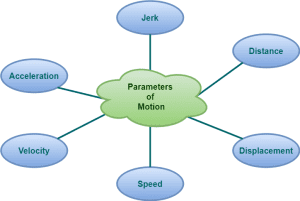
- Distance
- Displacement
- Speed
- Velocity
- Acceleration
- Jerk
Before you go through this article, make sure that you have gone through the previous article on Speed and Velocity.
In this article, we will discuss about acceleration.
Acceleration-
| It is defined as the rate of change of velocity of a body with time. |
Mathematically,

Characteristics of Acceleration-
- The SI unit of acceleration is meter per square second (m/s2).
- The dimensional formula of acceleration is [LT-2].
- It has both magnitude and direction. Hence, it is a vector quantity.
- The direction of acceleration is same as direction of change in velocity.
- It may be positive, negative or zero.
Also Read- Distance & Displacement
Example On Acceleration-
Consider a car starting from rest acquires a speed of 50 m/s in 5 seconds. Then, its acceleration is given by-
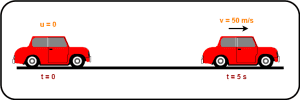
Acceleration
= Change in velocity / Time taken
= (Final velocity – Initial velocity) / Time taken
= (50 – 0) / 5
= 10 m/s2
Different Types of Acceleration-
There are following 4 different types of acceleration-
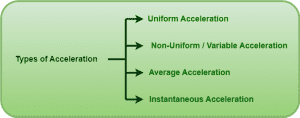
1. Uniform Acceleration
2. Variable Acceleration
3. Average Acceleration
4. Instantaneous Acceleration
1. Uniform Acceleration-
| The acceleration of a body is said to be uniform acceleration if its velocity changes by equal amounts in equal intervals of time. |
2. Variable Acceleration-
| The acceleration of a body is said to be variable acceleration if its velocity changes by unequal amounts in equal intervals of time. |
3. Average Acceleration-
| For a body moving with variable velocity,
the average acceleration is defined as the ratio of the total change in velocity of the body to the total time interval taken. |
Mathematically,

Suppose-
- At time t1, initial velocity of the body = u
- At time t2, final velocity of the body = v
Then, its average acceleration is-
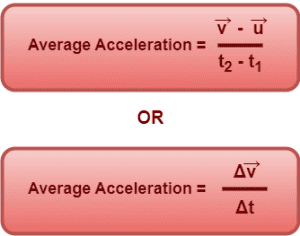
4. Instantaneous Acceleration-
| The acceleration of the body at a given instant of time is called its instantaneous acceleration. |
It is equal to the limiting value of the average acceleration of the body in small time interval around that instant, when the time interval approaches zero.
Thus,
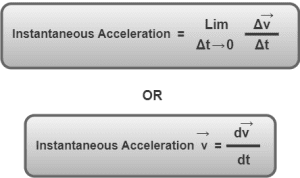
NOTEThe instantaneous acceleration of a body is equal to the first order derivative of velocity and second order derivative of position with respect to time. |
Relation Between Direction of Velocity & Acceleration-
It is important to remember the following two points-
- If velocity and acceleration are in the same direction, then velocity of the body increases.
- If velocity and acceleration are in the opposite directions, then velocity of the body decreases.
When acceleration acts in the opposite direction of velocity, it is called as retardation.
Read the next article on-
Get more notes and other study material of Motion in One Dimension.

